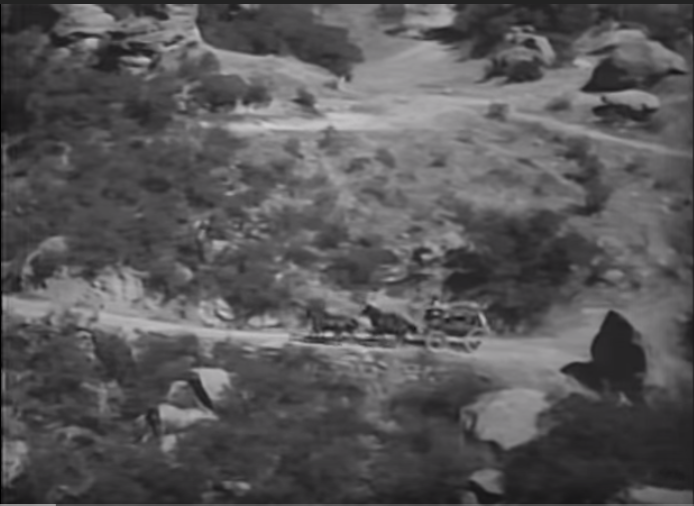What I watched: The twenty-sixth episode of the first season of The Lone Ranger, a kid-oriented Western created by George W. Trendle. This episode starred Clayton Moore as the titular hero and Jay Silverheels as Tonto, with guest appearances by Eula Morgan, Harry Lauter and Dick Alexander. This episode was directed by George Archainbaud and written by Herb Meadow based on a story by Doris Schroeder. “Troubled Waters” aired on Thursday, March 9, 1950 at 7:30 PM on ABC, and is available to watch on YouTube.
What happened: The Ranger and Tonto arrive, parched, to what Tonto describe as a “dry county.” I think he’s using the term very literally. They encounter a woman in the buggy named Emmy Bryson (Morgan), who naturally thinks they’re outlaws, but tells them to hit up the Circle J ranch for water. Our heroes find a puddle and start drinking from it, but a man starts promptly shooting at them. Hey, you’ve got to protect your puddle.

They track the man, Dave Tucker (Lauter), down to his cabin. It turns out that he also distrusts the Ranger, thinking that he’s come to poison the water. They sit down to tea, and Tucker says that he’s in bad straits with a broken arm, debts to pay, and someone trying to ruin his life.
In town, we see Bryson berating a mentally-slow guy named Jed (Alexander). We learn that she’s the villain of this episode, and has sent Jed to “take care of” Tucker. The Ranger comes in, and Jed tries to fight him, but Bryson stops him. There’s some stuff about how she owns part of the ranch and wants him to sell.
The Ranger goes to see Barton, the banker, who turns out to be an old friend. Barton protests that times are hard and he’s not rich. I’m sure this guy has written a Washington Post op-ed. The Ranger says that Tucker’s water has gone bad because oil is coming up through the pond, which could make the property much more valuable. But someone has overheard, and they shoot the good banker dead. I wonder who it could be.
When he gets back to the ranch, the Ranger finds that Tonto has been knocked out. Tucker says that someone has let all the cattle out — a “goblin”, as he says. I remember that D&D adventure. In the town, the sheriff wants to arrest the Ranger for the murder, but Bryson takes things into her own hands and starts shooting, presumably because there are only six minutes left in the episode.
Our heroes quickly summon a massive wall of chairs to barricade the doors, but Jed is still inside and starts brawling with the Ranger. Bryson wades into the battle, and shoots Tucker. But Tonto gets the jump on her, and the Ranger eventually knocks out big Jed. The Ranger convinces the sheriff to arrest the woman, and Jed is finally tired of his mistreatment and willing to snitch on his employer. Hooray!
What I thought: After being an all-male affair for the first few episodes, the presence of women on The Lone Ranger has been raising steadily. Here, we have the first female villain — well, I suppose the wife from “Man of the House” was a villain, but she wasn’t the one hatching criminal schemes that our hero had to stop. Mrs. Bryson is almost likable — she has the same kind of hard-bitten, androgynous folksiness that past women on this show have had, she’s just a little more ruthless.

Maybe there is a little bit of similarity between Bryson and that shrewish wife from the episode I hated. Her evilness is established entirely through her cruelty through men, both Tucker and her slow-witted henchman. Jed’s confession at the end is reminiscent of the suicidal bros-before-hos moment at the end of The Hateful Eight, realizing that loyalty to his gender and its project of domination overrides material concerns. And yet, the punishment of Bryson never feels as cruel or gratuitous as that of the more innocent housewife. There’s a certain amount of respect for the industrious villain.
And is it just me, or is it remarkable just how often the Ranger and Tonto are mistaken for criminals? It happens multiple times in this episode, with every guest character good or bad greeting them at gunpoint. In part, this is simply a way to wring out a minute or two of action when the screenplay is a little light. (This is the same reason why confrontations between people who will be on the same side became a staple trope of superhero comics.)
But these confrontations are also a result of the series’s central contradiction that I’ve pointed out before: that the vigilante Ranger is both an outlaw and an enforcer of the law. The series is forced to covertly acknowledge that any reasonable person would be suspicious of this masked man taking an unusual interest in your problems. It will be interesting to see if this contradiction is resolved or continue to bubble up in future episodes. Hey, I have to find something to be interested in about this show.
Coming up next: Ed Wynn brings in another classic silent comedy act.




